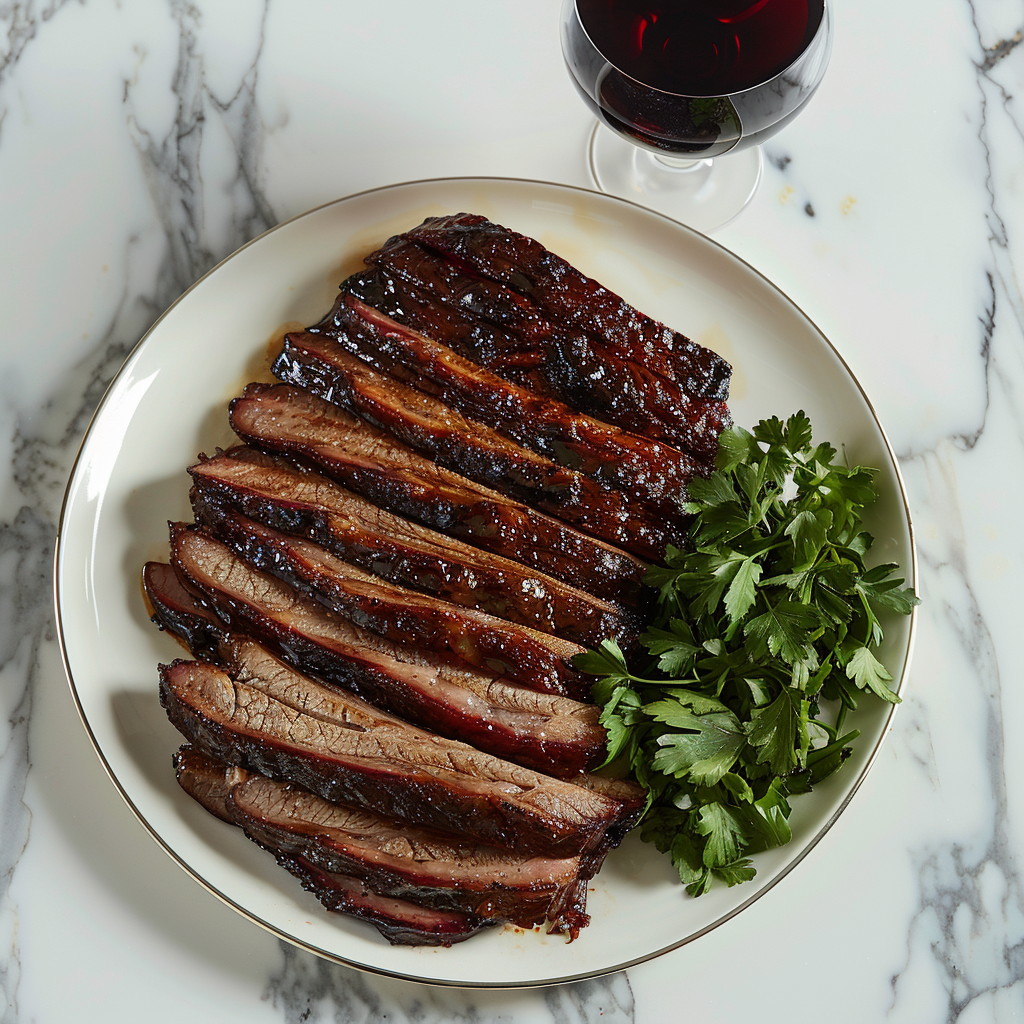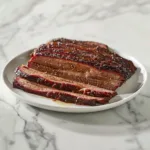Brining is the secret to taking your barbecue from good to great. This technique involves soaking the brisket in a salt-based solution. Not only does this step boost the flavor and texture of the meat, but it also guarantees that every brisket you cook will be moist, tasty, and tender.
Overview of Ingredients
The basic brisket brine consists of water, salt, and sugar, but the variations are limitless depending on your taste preferences and dietary needs. Key ingredients include:
Water: The base of any brine.
Salt: Kosher salt is preferred for its purity and taste.
Sugar: Brown sugar is common, but honey or maple syrup can be substituted.
Additional flavorings: Garlic, bay leaves, peppercorns, and mustard seeds.
Substitutes and alternatives are available for those with dietary restrictions, ensuring everyone can enjoy a delicious brined brisket.
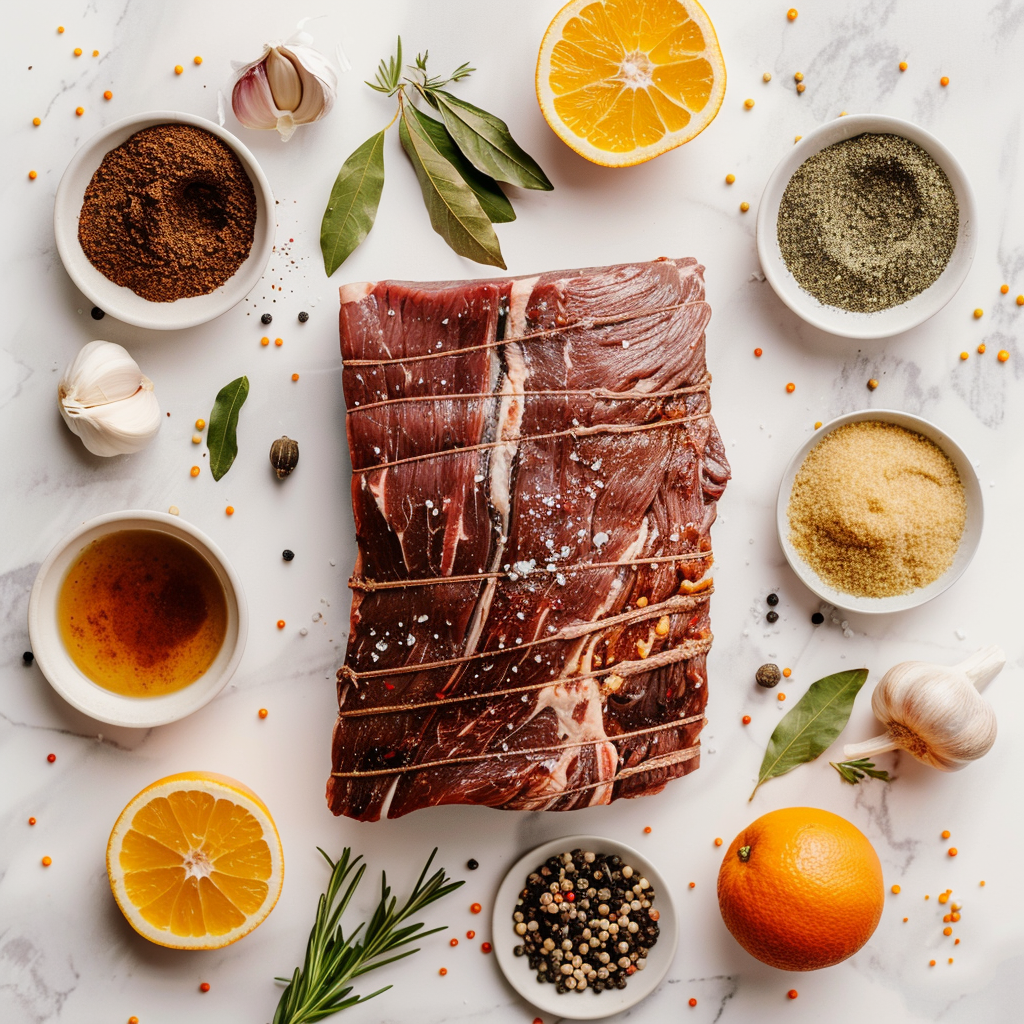
Chef’s Tips for Perfect brisket brine
Achieving the perfect brisket involves not only selecting the right cut but also applying the brining and cooking methods effectively. Here are some invaluable insights and best practices to help you master your brisket preparation:
Brining Essentials
Brisket should ideally be brined in a solution made primarily of water, salt, and sugar, with possible additions of spices and herbs to enhance the flavor. The purpose of brining is to increase the moisture retention of the meat during cooking, making it juicier and more flavorful.
Duration of Brining
You can brine a brisket for 12 to 24 hours. Beyond this time frame, the brisket can become overly salty and the texture may start to degrade, which can affect the quality of your final dish.
Brine vs. Injection
While injecting a brisket can directly introduce flavor and moisture deep into the meat, brining tends to enhance the overall texture and moisture retention through osmosis. For those looking for a uniformly seasoned and tender brisket, brining is generally the preferred method.
Effective Brining Techniques
The best brine method involves fully submerging the brisket in your brine solution in a large enough container to ensure even coverage. It’s crucial to keep the brisket refrigerated during this process to prevent bacterial growth.
The Role of Salt
Salt is a critical component of the brine, helping to tenderize the brisket by breaking down some of the protein structures. This not only helps in moisture retention but also makes the meat tender.
Ensuring Tender Brisket
The secret to a tender brisket lies in the slow cooking process. Cooking brisket at low temperatures, typically around 225°F (107°C), allows the connective tissues to break down without drying out the meat, which is essential for achieving that fall-apart texture.
Keeping Brisket Moist
To ensure the brisket remains moist during cooking, consider using a pan of water inside the smoker or oven to maintain humidity. This helps in keeping the brisket moist and tender. The best liquids for maintaining moisture in the brisket include broth, apple juice, or a simple mix of water and vinegar.
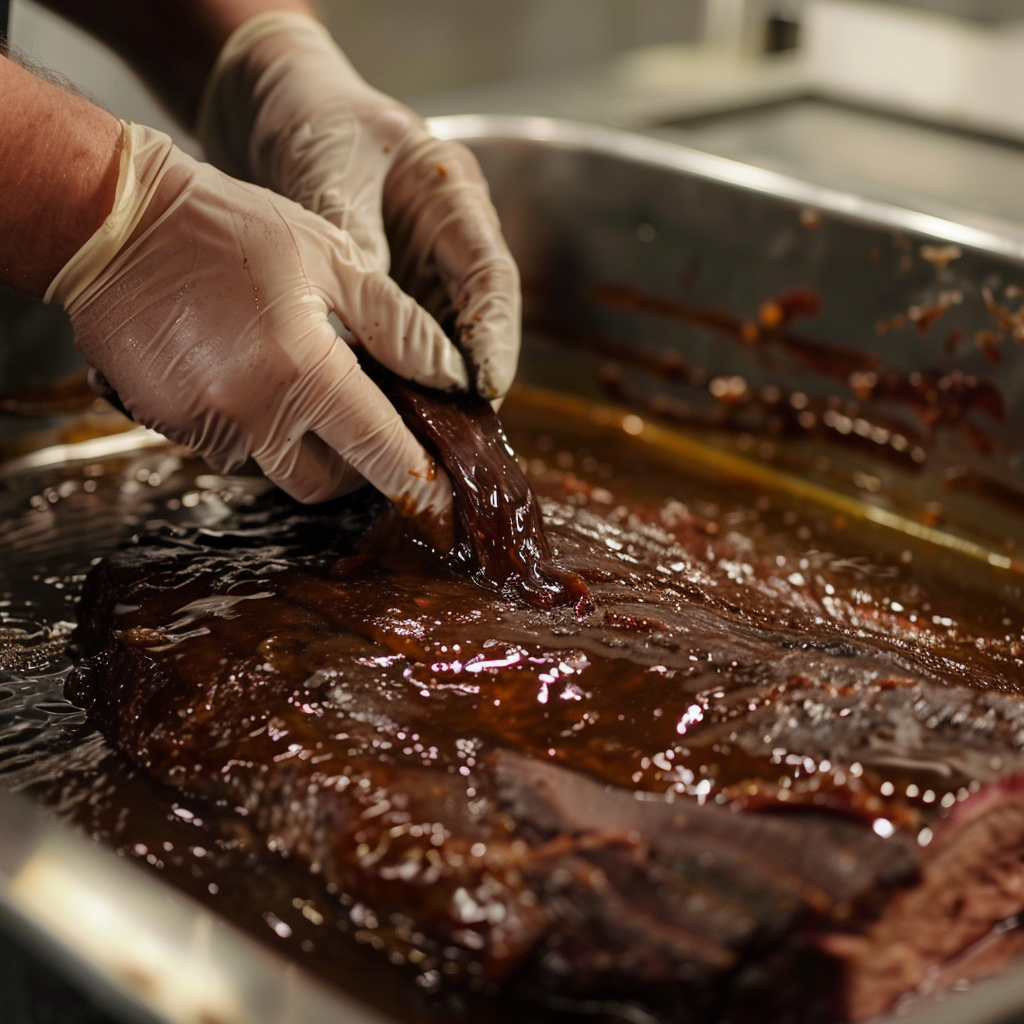
Optimal Cooking Temperature for brisket brine
Brisket becomes tender and starts to “fall apart” at an internal temperature around 195°F to 205°F (90°C to 96°C). It’s important to monitor the temperature closely with a meat thermometer to prevent overcooking.
By following these tips, you can ensure your brisket is not only flavorful but also tender and juicy, providing a delightful eating experience for all your guests.
Customize Your Brisket Brine
Customizing your brisket brine allows you to infuse unique flavors that can significantly enhance the overall taste of your brisket. Here are some creative ideas and additions to help you tailor your brine to your specific taste preferences:
Citrus and Zest
Adding slices of orange, lemon, or lime to your brine can impart a subtle citrus note, which pairs wonderfully with the rich flavor of brisket. The zest of these fruits can also be included for a more pronounced aroma.
Aromatics
Onion and garlic are fundamental aromatics that can be added in whole cloves or chopped form. They provide a robust base flavor that is essential in many meat preparations. For a different twist, try shallots or leeks, which provide a milder onion-like flavor.
Smokey Flavors
For a smokey touch, consider adding liquid smoke directly into the brine. This can mimic the flavors of traditional smoking without the need for a smoker.
Acidic Components
Incorporating a splash of apple cider vinegar or red wine can help tenderize the brisket and add a layer of complexity to the taste. The acidity also balances the richness of the meat.
Beer or Wine
Substituting part of the water with beer or wine can introduce complex flavors, depending on the type used. Dark beers or robust wines like cabernet sauvignon can enhance the depth of the brine.
International Flavors
For a global twist, add ingredients like soy sauce for an Asian flair or a mix of cumin and coriander for a Middle Eastern touch. These elements introduce new flavor profiles that can make your brisket stand out.
By customizing your brine, you can create a signature dish that stands out at any barbecue. For a detailed guide on cooking techniques, see this comprehensive guide to perfectly cooked meat.
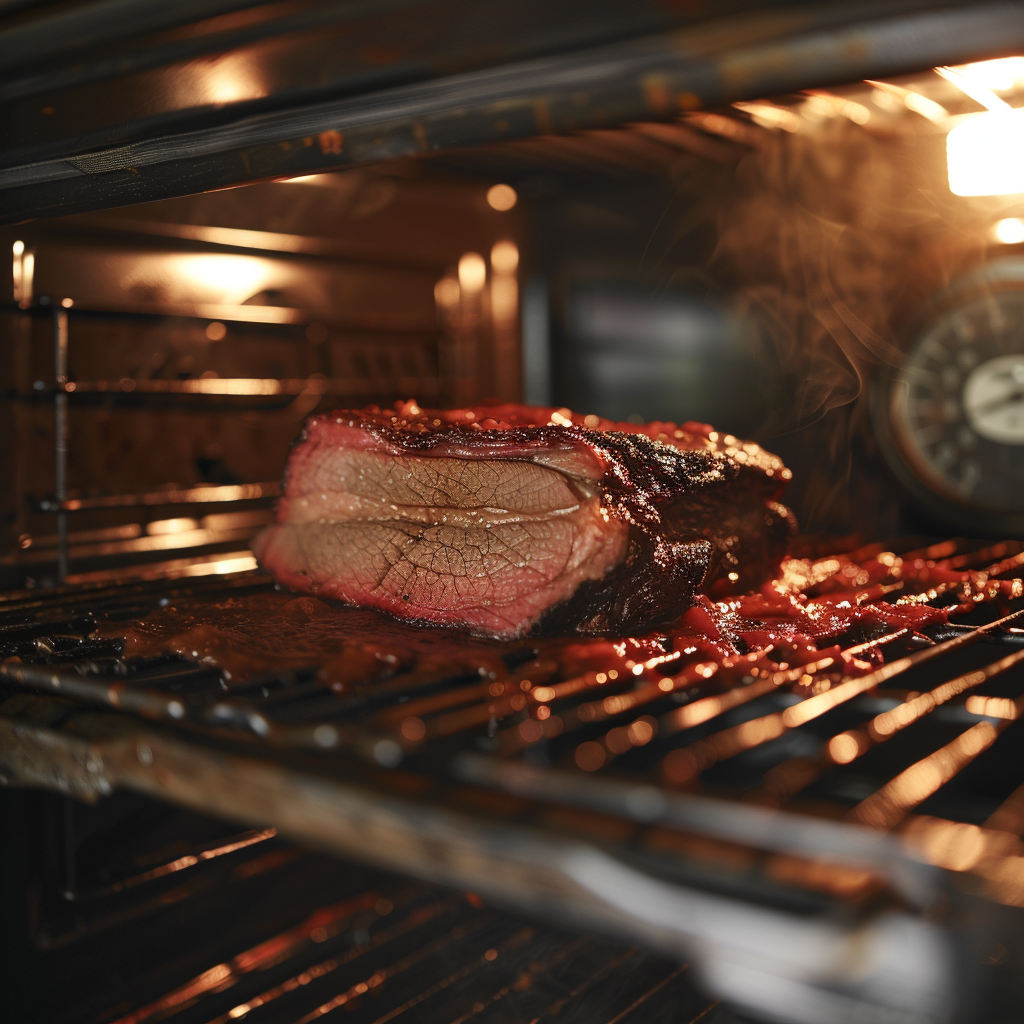
What goes best with Brisket marinade
The right side dishes can enhance your brisket meal dramatically. Consider serving your brisket with the following:
Classic coleslaw
Grilled vegetables
Cornbread
Each side dish complements the rich flavors of the smoked brisket, making for a well-rounded meal.
Wines
Pairing the right drink or wine with brisket, particularly when it’s been brined and possibly smoked, can enhance the dining experience by complementing the rich and savory flavors of the meat. Here are some excellent options:
Zinfandel: This red wine is a classic pairing with barbecued meats due to its bold fruit flavors and spice notes that complement the smokiness of brisket.
Cabernet Sauvignon: Known for its deep flavor and firm tannins, Cabernet Sauvignon can stand up to the richness of brisket, balancing the fatty content beautifully.
Syrah/Shiraz: Offering spicy and dark fruit flavors, Syrah matches well with the robust flavors of a seasoned brisket.
Merlot: For those preferring something smoother, Merlot provides a softer option with plenty of depth to handle the brisket without overpowering it.
Beers
Porter or Stout: These dark beers, with their roasted malt flavors, are natural complements to the deep, smoky flavors of brisket.
American Pale Ale: The hoppy character of a pale ale can cut through the fat of brisket, refreshing the palate with each sip.
Brown Ale: Offering a balance of malt sweetness and mild bitterness, brown ales can enhance the inherent flavors of brisket without overwhelming them.
Non-Alcoholic Options
Iced Tea: Sweet or unsweetened, iced tea is a refreshing choice that cleanses the palate, especially when enjoying a heavily seasoned brisket.
Lemonade: The sweetness and tartness of lemonade provide a refreshing counterbalance to the richness of brisket.
Sparkling Water: A bubbly, unsweetened sparkling water with a slice of lemon or lime can help refresh the palate between bites of fatty brisket.
Spirits
Bourbon: The sweet, woody notes of bourbon pair wonderfully with smoked or barbecued brisket.
Rye Whiskey: The spicy characteristics of rye whiskey make it an excellent match for the robust flavors of brisket.
Choosing the right beverage to serve with brisket can turn a simple meal into a memorable dining experience, whether you opt for wine, beer, a non-alcoholic drink, or spirits. Each option offers a unique way to complement the flavors of the brisket.

Health Benefits of smoked brisket
Brisket is not only delicious but also offers various health benefits when prepared properly:
Protein-Rich: Brisket is a great source of lean protein, essential for muscle repair and growth.
Minerals and Vitamins: It contains iron, zinc, and B vitamins.
Understanding these benefits can help you appreciate the brisket even more. For more detailed nutritional information, explore nutritional information for beef brisket.
PrintGuide to Brisket Brine: Recipes, Tips, and Pairings
Elevate your BBQ game with expert tips, pairings, and a detailed recipe to make the perfect brisket brine.
- Prep Time: 20 minutes
- Cook Time: 7 hours
- Total Time: 7 hours 20 minutes
- Yield: 4-6
- Category: Main Course
- Method: Brining, Smoking
- Cuisine: American
Ingredients
- 6 quarts water
- 1 cup light brown sugar
- 1/2 cup kosher salt
- 2 oranges, sliced (for added citrus flavor)
- 4 bay leaves
- 1 tablespoon peppercorns
- 1 large brisket (about 5–7 pounds)
- Additional aromatics (optional): garlic cloves, rosemary sprigs
Instructions
- In a large pot, combine water, brown sugar, and kosher salt. Bring to a boil to dissolve the solids.
- Remove from heat. Add the orange slices, bay leaves, and peppercorns. Allow the mixture to cool completely.
- Place the brisket in a large container. Pour the cooled brine over the brisket, ensuring it is completely submerged. Add additional cold water if needed.
- Cover and refrigerate the brisket for 12 to 24 hours.
- Remove the brisket from the brine and pat dry with paper towels. Optionally, season with additional spices before cooking.
- Cook the brisket in a preheated smoker or oven at 225°F until the internal temperature reaches 195°F.
- Allow the brisket to rest for at least 30 minutes before slicing against the grain.
Notes
- Ensure the brine is cooled completely before adding the brisket to prevent premature cooking.
- If desired, add a splash of apple cider vinegar to the brine to enhance tenderness.
- For a more pronounced flavor, consider adding other spices such as cumin or smoked paprika to the brine mixture.
Keywords: Brisket Brine Recipe. Brisket marinade, smoked brisket recipe, beef brine technique

